WHAT CAN A BODY DO? AT HAVERFORD COLLEGE
From October 26 to December 19 of this year Haverford College in suburban Philadelphia is hosting an impressive event called "What Can a Body Do?" Despite its academic reputation, Haverford is too small a college to house a Disability Studies program, but the current exhibit demonstrates just what kind of contributions smaller colleges can make to disability studies.
"What Can a Body Do a Body Do?" is the brainchild of Kristin Lindgren, the director of Haverford's writing center. It combines the visual arts, poetry and scholarship. Lindgren began to develop the program in earnest two years ago when Haverford College hosted the symposium "in/visible: Disability and the Arts" that included Tobin Siebers, Georgina Kleege, Katherine Sherwood, Ann Fox and Jessica Cooley provide presentations illustrating how how disabilities points of view can inform classic works of art. The centerpiece of Haverford's current program is an exhibit assembled in the Cantor Fitzgerald Gallery by curator Amanda cachia, whose description of the exhibit can be read in the September issue of Wordgathering. cachia gathered together the works of Joseph Grigely, Christine Sun Kim, Park McArthur, Alison O'Daniel, Laura Swanson, Chun-Shan (Sandie) Yi, Corban Walker and Artur Zmijewski, many of whose work she was familiar with as the curator of a similar event with disabilities related art in San Francisco.
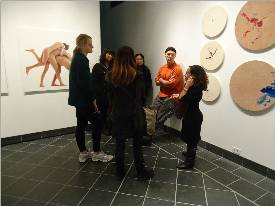
Amanda cachia (right) discusses the exhibit in the Cantor Fitzgerald Gallery
In connection with the exhibit itself Lindgren pulled together other events that spotlighted work being done in disabilities and the arts. The list of events included a performance by artist Christine Sun Kim, conversations with cachia and O'Daniel and "Blind Field Shuttle" a non-visual walking tour led by Carmen Papalia. Literature was highlighted through a reading from work in Beauty is a Verb: The New Poetry of Disability, a 2112 ALA
Abbrev notable book Regional poets Anne Kaier, Michael Northen, Daniel Simpson and Hal Sirowitz whose work is included in the anthology read their poems.
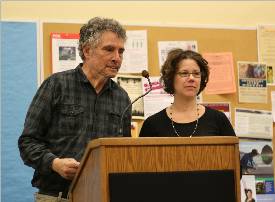
Poet Hal Sirowitz and writer Minter Krotzer read from Hal's work in Beauty is a Verb.
Disability studies pioneer Rosemarie Garland-Thompson anchored the scholarship aspect of the exhibit with her lecture "Building a World with Disabilities in It." Garland-Thompson's lecture pivoted from art to bioethics by moving from classic portrayals in art such as Bruegel's "The Cripples," showing how people with disabilities have always been present in common culture, to the two different attitudes disability in current social policy. The first approach Garland Thompson calls the eugenics approach: the use of scientific tools and modern technology such as genetic testing to eliminate disability from the world. The second approach is to view the accommodations for and the accomplishments of people with disabilities as significant contributions that benefit society as a whole. Lindgren's inclusion of Garland-Thompson in the program drew together regional disability scholars who were given the opportunity to discuss her ideas surrounded by the art cachia provided.
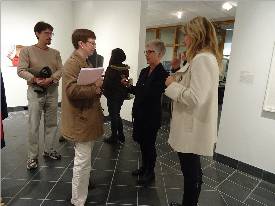
Rosemarie Garland-Thompson (center) talks with Delaware University professor Stephanie Kershbaum (left) and ASL interpreter Doreen Kelley (right).
One of the nice touches of the exhibit were the explanatory descriptions mounted on the gallery walls. Though such explanations may not set well with art purist, they served the important educational function of helping gallery goes who are not art savvy how individual artists used their experiences with disability to inform their art. As Tobin Siebers observed in the talk that helped generate the ideas for "What Can a Body Do?", the disabilities viewpoint in art helps the mainstream to understand itself. That is exactly what the individual pieces in this exhibit can do, and the descriptions help enable this process. Audio recordings describing the exhibit were available in the gallery, and ASL interpreters were provided at the major events.
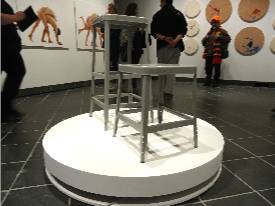
Artist Laura Swanson's "Display with Stools."
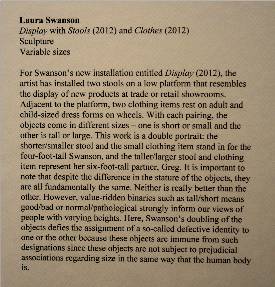
Disability Studies isn't Big Ten football. It is not going to draw big money or big crowds. For small academic institutions, though, this is not necessarily a disadvantage. It offers them the chance to be a part of and make significant contributions to a still emerging field. Kristin Lindgren and her colleagues at Haverford College are showing how it is done.